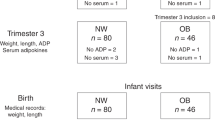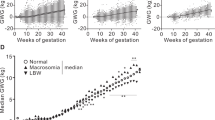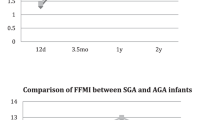Abstract
This study explored the relationship of maternal body composition parameters to the birth weight of the offspring. Maternal anthropometric parameters (weight, height) and body composition by dual energy X-ray absorptiometry were measured in 76 women from low-income group during 12–21 days postpartum. The mean±s.d. height, weight of the mothers and birth weight of the newborns were 151.5±5.29 cm, 46.7±6.04 and 2.84±0.358 kg, respectively. When the relationship of maternal anthropometric and body composition parameters to the infants' birth weight was studied, maternal lean body mass was found to be the most important determinant of birth weight (R2 (%)=21.3) (P<0.001). This study highlights the importance of increasing lean body mass in young women for better pregnancy outcome.
This is a preview of subscription content, access via your institution
Access options
Subscribe to this journal
Receive 12 print issues and online access
$259.00 per year
only $21.58 per issue
Buy this article
- Purchase on Springer Link
- Instant access to full article PDF
Prices may be subject to local taxes which are calculated during checkout
Similar content being viewed by others
References
Alam DS, van Raaij JMA, Hautvast JGAJ, Yunus M, Fuchs GJ (2003). Energy stress during pregnancy and lactation: consequences for maternal nutrition in rural Bangladesh. Eur J Clin Nutr 57, 151–156.
Annual Report (2002) Annual Report, National Institute of Nutrition, Indian Council of Medical Research, India, 2002.
Annual Report (2003) Annual Report, National Institute of Nutrition, Indian Council of Medical Research, India, 2003.
Barker DJ (2004). The developmental origins of adult disease. J Am Coll Nutr 23, 588S–595S.
Briend A (1985). Do maternal energy reserves limit fetal growth? Lancet 1, 38–40.
Christian P, Khatry SK, Katz J, Pradhan EK, Le Clerq SC, Shrestha SR et al. (2003). Effects of alternative maternal micronutrient supplements on low birth weight in rural Nepal: double blind randomised community trial. BMJ 326, 571.
Ehrenberg HM, Dierker L, Milluzzi C, Mercer BM (2003). Low maternal weight, failure to thrive in pregnancy and adverse pregnancy outcomes. Am J Obstet Gynecol 189, 1726–1730.
Hytten FE (1991). Weight gain in pregnancy. In: Hytten FE, Chamberlain G (eds). Clinical Physiology in Obstetrics, 2nd edn. Blackwell Scientific: Oxford, pp 173–203.
Kramer MS (1987). Determinants of low birth weight: methodological assessment and meta-analysis. WHO Bull 65, 663–737.
Kramer MS, Kakuma R (2003). Energy and protein intake in pregnancy. Cochrane Database System Review 4, (CD000032).
Langhoff-Roos J, Lindmark G, Gebre-Medhin M (1987). Maternal fat stores and fat accretion during pregnancy in relation to infant birth weight. Br J Obstet Gynaecol 94, 1170–1177.
Misra A, Vikram N (2002). Insulin resistance syndrome (metabolic syndrome) and Asian Indians. Curr Sci 83, 1483–1496.
Naidu AN, Rao NP (1994). Body mass index: a measure of the nutritional status in Indian populations. Eur J Clin Nutr 48 (Suppl 3), S131–S140.
National Nutrition Monitoring Bureau (2002) National Nutrition Monitoring Bureau, National Institute of Nutrition, Hyderabad, India.
Neggers Y, Goldenberg RL (2003). Some thoughts of body mass index, micronutrient intakes and pregnancy outcome. J Nutr 133, 1737S–1740S.
Raman L, Visweswara Rao K, Adinarayana K, Rawal A, Vasumathi N, Parvati CH et al. (1995). Risk care approach to anaemia in pregnancy in an urban slum. WHO Bull 73 (Suppl), 75–76.
Rayco-Solon P, Fulford AJ, Prentice AM (2005). Differential effects of seasonality on pre-term birth and intrauterine growth restriction in rural Africans. Am J Clin Nutr 81, 134–139.
Ronnenberg AG, Wang X, Xing H, Chen C, Chen D, Guang W et al. (2003). Low preconception body mass index is associated with birth outcome in a prospective cohort of Chinese women. J Nutr 133, 3449–3455.
Shatrugna V, Balakrishna N, Krishnaswamy K (2006). Effect of micronutrient supplement on health and nutritional status of school children – bone health and body composition. Nutrition 22 (Suppl 1), S33–S39.
Stein Z, Susser M, Saenger G, Marolla F (1975). Famine and Human Development: The Dutch Hunger Winter of 1944/45. Oxford University Press: New York.
Thame M, Osmond C, Bennett F, Wilks R, Forrester T (2004). Fetal growth is directly related to maternal anthropometry and placental volume. Eur J Clin Nutr 58, 894–900.
UNICEF (2004). The State of the World's Children. UNICEF: New York, p 107.
WHO (1995). Maternal anthropometry and pregnancy outcomes: a WHO collaborative study. WHO Bull 73 (Suppl), 1–98.
Yajnik CS (2001). The insulin resistance epidemic in India. Fetal origins, later lifestyle or both? Nutr Rev 50, 1–9.
Young CM, Young KM (1985). Effects of varying degrees of chronic dietary restriction in rat dams on reproductive and lactational performance and body composition in dams and their pups. Am J Clin Nutr 41, 979–998.
Acknowledgements
We would like to place on record the support and encouragement of Dr B Sivakumar, Director, National Institute of Nutrition, Hyderabad. We are thankful to Mr AN Naidu, Deputy Director (Retired), National Institute of Nutrition, Hyderabad, Professor K Ramachadran, Chennai and Dr AV Kurpad, Professor, St John's Medical College, Banglore, who reviewed the manuscript and gave valuable suggestions. We are also grateful to Ms Usha Rani, Mr Sambasiva Rao, Ms Prema Kumari, Ms Sundaramma and Ms Malini V Rao for their help during the course of the study. This study would not have been possible without the unstinted cooperation of the women who were the subjects of the study and we are grateful to them.
Author information
Authors and Affiliations
Corresponding author
Additional information
Guarantor: Dr V Shatrugna.
Contributors: BK and VS contributed to the study design, subject recruitment, interpretation of the results and manuscript preparation. NB carried out the statistical analysis of the data.
Rights and permissions
About this article
Cite this article
Kulkarni, B., Shatrugna, V. & Balakrishna, N. Maternal lean body mass may be the major determinant of birth weight: a study from India. Eur J Clin Nutr 60, 1341–1344 (2006). https://doi.org/10.1038/sj.ejcn.1602461
Received:
Revised:
Accepted:
Published:
Issue Date:
DOI: https://doi.org/10.1038/sj.ejcn.1602461
Keywords
This article is cited by
-
An assessment of India's multiple national social protection schemes in improving nutrition and health
Food Security (2023)
-
Newborn low birth weight: do socio-economic inequality still persist in India?
BMC Pediatrics (2021)
-
Ancient origins of low lean mass among South Asians and implications for modern type 2 diabetes susceptibility
Scientific Reports (2019)
-
Maternal central obesity and birth size: a Mendelian randomization analysis
Lipids in Health and Disease (2018)
-
Maternal fat free mass during pregnancy is associated with birth weight
Reproductive Health (2017)



